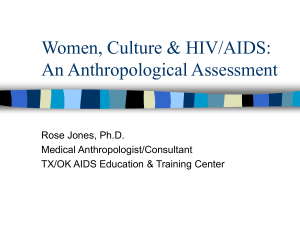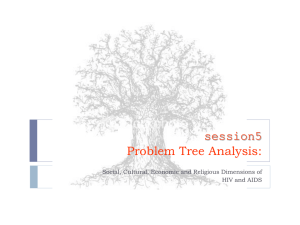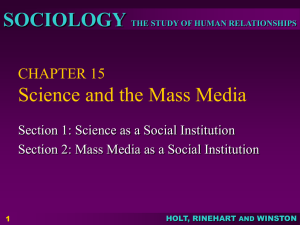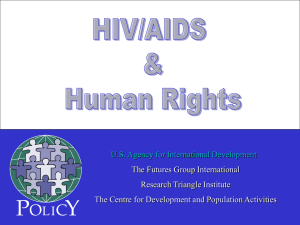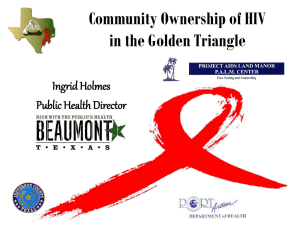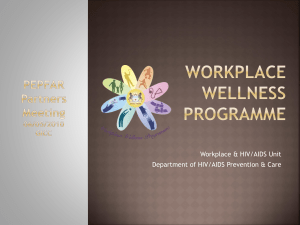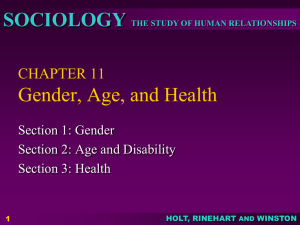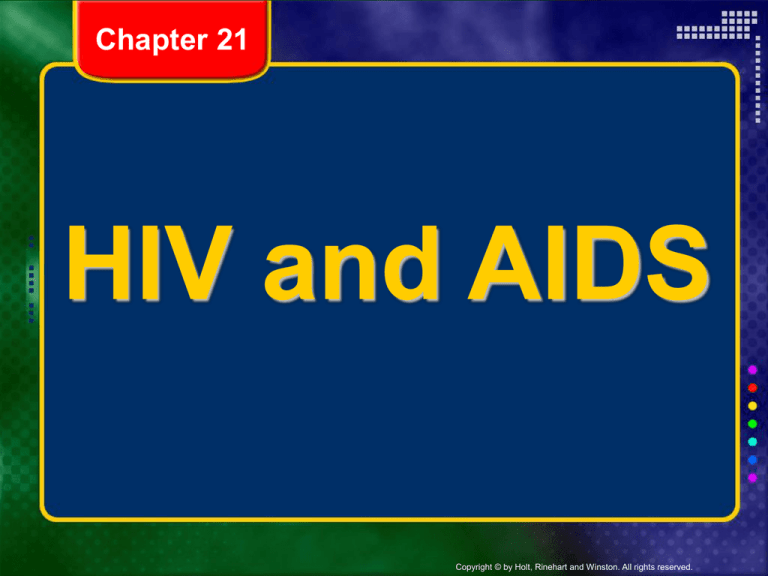
Chapter 21
HIV and AIDS
Copyright © by Holt, Rinehart and Winston. All rights reserved.
Chapter 21
What’s your Health IQ?
TRUE / FALSE
You can tell if a person is infected
with HIV by looking at them.
Copyright © by Holt, Rinehart and Winston. All rights reserved.
FALSE!
•It can take years to show the first
symptoms of an HIV infection.
•An infected person can carry and
spread the disease to others during
this time.
Copyright © by Holt, Rinehart and Winston. All rights reserved.
Chapter 21
What’s your Health IQ?
TRUE / FALSE
If you drink from a water fountain
after a person who’s infected with
HIV, you are at risk of becoming
infected.
Copyright © by Holt, Rinehart and Winston. All rights reserved.
FALSE!
HIV is NOT transmitted through
casual contact, such as drinking
from water fountains, holding hands,
hugging, “basic” kissing, etc.
Copyright © by Holt, Rinehart and Winston. All rights reserved.
Chapter 21
What’s your Health IQ?
TRUE / FALSE
If you donate blood at a school
blood drive (or at the South TX
Blood and Tissue Center) you are at
risk of becoming infected with HIV /
AIDS.
Copyright © by Holt, Rinehart and Winston. All rights reserved.
FALSE!
Sterile, single-use needles are used
during blood donations in the U.S.,
so blood donors are not at risk of
HIV infection.
Copyright © by Holt, Rinehart and Winston. All rights reserved.
Chapter 21
What’s your Health IQ?
TRUE / FALSE
Most people who are infected
with HIV know it and will warn
others.
Copyright © by Holt, Rinehart and Winston. All rights reserved.
FALSE!
Many HIV-infected people are
unaware of their infection and
therefore cannot warn anyone else.
Copyright © by Holt, Rinehart and Winston. All rights reserved.
ATTENTION STUDENTS:
TAKE NOTES ON THE
INFORMATION IN RED
Copyright © by Holt, Rinehart and Winston. All rights reserved.
Chapter 21
HIV and AIDS
Contents
Section 1 HIV and AIDS Today
Section 2 Understanding HIV and AIDS
Section 3 Protecting Yourself from HIV and AIDS
Copyright © by Holt, Rinehart and Winston. All rights reserved.
Chapter 21
Section 1
HIV and AIDS Today
Copyright © by Holt, Rinehart and Winston. All rights reserved.
Chapter 21
Section 1 HIV and AIDS Today
What Are HIV and AIDS?
Human Immunodeficiency Virus (HIV):
• the virus that destroys the immune system
• the virus that causes AIDS
Acquired immune deficiency syndrome (AIDS):
• People with AIDS cannot fight off illnesses that a
healthy immune system could normally defeat
(opportunistic infections)
Copyright © by Holt, Rinehart and Winston. All rights reserved.
Chapter 21
Section 1 HIV and AIDS Today
HIV Around the World
• AIDS is a pandemic, a disease that spreads quickly
through human populations all over the world.
• More than 20 million people have died from AIDS
since HIV was first discovered around 30 years ago.
• AIDS is the leading cause of death in sub-Saharan
Africa (southern half of the continent).
Copyright © by Holt, Rinehart and Winston. All rights reserved.
Copyright © by Holt, Rinehart and Winston. All rights reserved.
Chapter 21
Section 1 HIV and AIDS Today
HIV in the United States
• CDC (2008) estimates that:
• ~56,300 new HIV infections every year in the U.S.
(about full capacity of the Alamo Dome)
• >1,000,000 people are currently living with
HIV / AIDS in the U.S.
• ~25% of these are undiagnosed and/or
unaware of their infection!
•CDC estimated 36,828 deaths in the U.S. in 2006
Copyright © by Holt, Rinehart and Winston. All rights reserved.
Statistics (CDC)
Estimated New HIV Infections, by Age, 2006
Copyright © by Holt, Rinehart and Winston. All rights reserved.
1987
2007
1997
In 2007: 62,714 Texans
were living with HIV/AIDS
(Texas Department of
Health)
Copyright © by Holt, Rinehart and Winston. All rights reserved.
Chapter 21
Section 1 HIV and AIDS Today
Teens and HIV
• Teens, especially female minorities, are among the
fastest-growing groups to become infected with HIV.
• Over 10,000 teens have been diagnosed with HIV in
the United States. More than 4,000 of these have
developed AIDS.
• HIV is rising in teens because many teens do not
take the risks of HIV and AIDS seriously, and engage
in high-risk behaviors.
Copyright © by Holt, Rinehart and Winston. All rights reserved.
Chapter 21
AIDS STATISTICS
(2002-2003)
Copyright © by Holt, Rinehart and Winston. All rights reserved.
Chapter 21
STATE
NEW YORK
CALIFORINA
FLORIDA
4. TEXAS
NEW JERSEY
ILLINOIS
PENNSYLVANIA
GEORGIA
MARYLAND
MASSACHUSETTS
2002
6,741
4,228
4,979
3,076
1,456
2,111
1,789
1,471
1,848
808
2003
6,684
5,903
4,666
3,379
1,516
1,730
1,895
1,907
1570
757
TOTAL
162,446
133,292
94,725
62,983
46,703
30,139
29,988
27,915
26,918
18,525
Copyright © by Holt, Rinehart and Winston. All rights reserved.
Chapter 21
STATE
2002
2003
TOTAL
NORTH DAKOTA
3
3
115
SOUTH DAKOTA
11
13
218
WYOMING
11
8
212
MONTANA
17
7
366
VERMONT
12
16
457
TOTALS
42,336
43,704
872,629
Copyright © by Holt, Rinehart and Winston. All rights reserved.
Chapter 21
COUNTY
HARRIS
TOTAL
20,139
DALLAS
12,810
3. BEXAR
TRAVIS
TARRANT
EL PASO
TOTAL
4,255
3,921
3,414
1,276
60,078
Copyright © by Holt, Rinehart and Winston. All rights reserved.
Chapter 21
WHEN?
1981—AIDS was first discovered
WHERE?
UCLA Medical Center
WHAT?
A rare pneumonia known as
Pneumocystis Carinii Pneumonia (PCP)
was occurring more frequently than
before.
Copyright © by Holt, Rinehart and Winston. All rights reserved.
Chapter 21
1981
AIDS was first discovered
1983
HIV was discovered to be the CAUSE of AIDS
1985
First HIV test developed
NOW
Test of saliva for HIV antibodies reveals results
in 20 minutes
Copyright © by Holt, Rinehart and Winston. All rights reserved.
Chapter 21
Section 2
Understanding HIV and AIDS
Copyright © by Holt, Rinehart and Winston. All rights reserved.
Chapter 21
Section 2 Understanding HIV and
AIDS
How HIV Infects the Body
1. Helper T-cells are invaded by HIV
2. Invaded T cell is used to replicate many more copies
of HIV, killing the host T cell in the process
3. Bodies’ T cell count drops, weakening immune system
4. Body loses its ability to fight off infections, cancer, etc
5. An opportunistic infection infects the person, resulting
in severe illness or death.
Copyright © by Holt, Rinehart and Winston. All rights reserved.
Copyright © by Holt, Rinehart and Winston. All rights reserved.
Chapter 21
Section 2 Understanding HIV and
AIDS
THREE Ways That
HIV IS Spread
1. during sexual activity, which includes vaginal,
oral, and anal sex, with an infected person
2. through drug use with an infected person
(sharing needles or other paraphernalia)
3. from an infected mother to her infant before or
during the birth process or by breast-feeding.
Copyright © by Holt, Rinehart and Winston. All rights reserved.
Chapter 21
Section 2 Understanding HIV and
AIDS
Ways That HIV Is
NOT Spread
1. casual contact, including shaking hands, holding
hands, kissing, hugging, or playing sports with
an infected person
2. sharing bathroom facilities, drinking glasses, or
eating utensils
Copyright © by Holt, Rinehart and Winston. All rights reserved.
Chapter 21
Section 2 Understanding HIV and
AIDS
Teens at Risk for HIV (FACTS)
• Almost a 1/3 of the 40+ million people
living with HIV/AIDS are teens or young
adults.
• AIDS is the 8th leading cause of death
in the United States for people between
15 and 24.
Copyright © by Holt, Rinehart and Winston. All rights reserved.
Chapter 21
Section 2 Understanding HIV and
AIDS
Teens at Risk for HIV
• How do you know if you are at risk of
HIV? If you take part in any behavior
that could put you at risk, then you are
at risk.
• The only sure way to know if you are
infected with HIV is an HIV test. If you
think you are at risk, GET TESTED.
Copyright © by Holt, Rinehart and Winston. All rights reserved.
Chapter 21
Section 3
Protecting Yourself from HIV and AIDS
Copyright © by Holt, Rinehart and Winston. All rights reserved.
Chapter 21
Section 3 Protecting Yourself from
HIV and AIDS
Preventing HIV and AIDS
• The first step in preventing AIDS is to be
educated about HIV and AIDS.
• The only way to eliminate the risks of HIV
and AIDS is to avoid risky behaviors.
• Practice abstinence
• Avoid multiple partners
• Don’t share needles or other injection
equipment
• Avoid alcohol and illegal drugs
Copyright © by Holt, Rinehart and Winston. All rights reserved.
Chapter 21
Section 3 Protecting Yourself from
HIV and AIDS
Preventing HIV and AIDS
Universal precautions are a set of
procedures used to avoid contact with
bodily fluids and reduce the risk of
spreading HIV and other diseases:
• Latex gloves
• Goggles / face shields
• Gowns
Copyright © by Holt, Rinehart and Winston. All rights reserved.
Chapter 21
Section 3 Protecting Yourself from
HIV and AIDS
Treating HIV and AIDS
• No cure exists for HIV and AIDS.
• Treatment can help an infected person survive
longer.
• Drugs for treating HIV:
• are often not covered by traditional insurance
plans
• can have severe side effects
• can lose their effectiveness over time
• are expensive (sometimes >$1,000/month)
• require diligence and commitment (many
pills)
Copyright © by Holt, Rinehart and Winston. All rights reserved.
Chapter 21
Section 3 Protecting Yourself from
HIV and AIDS
Living with HIV Infection
• Most HIV-infected people in the early phases can
do almost everything they did before they got
infected.
• People infected with HIV must avoid participating
in activities that could expose others to HIV.
• Maintaining good health through treatment, diet,
exercise, and rest help delay the progression of
HIV to AIDS.
• Many HIV-infected people become activists for
HIV/AIDS prevention or help other infected people.
Copyright © by Holt, Rinehart and Winston. All rights reserved.
End of Chapter 21
Copyright © by Holt, Rinehart and Winston. All rights reserved.


